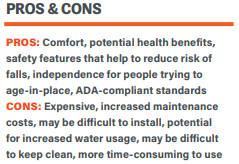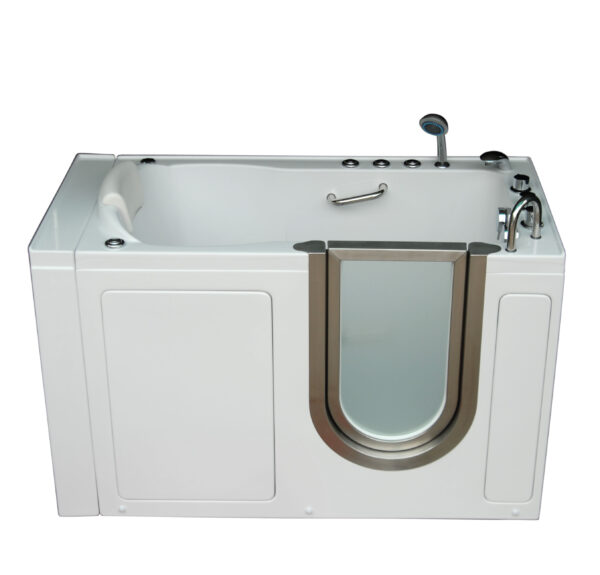
I recently had a reader ask for information regarding walk-in tubs. My experience with them is limited to a neighbor who purchased one for her mother who was living with her. After their house was sold, the new owner immediately tore out the tub. So, I did a lot of research to share with you.
Walk-in tubs have a hinged, water-tight door, a low threshold and built-in, chair-height seat. It may have therapy options, such as aerotherapy, hydrotherapy or chromatherapy.
Walk-in tubs provide safety and comfort. Entering a traditional tub can be risky for anyone with mobility issues. The Centers for Disease Control and Prevention reports that one in four Americans over the age of 65 falls each year getting in or out of a tub.
- There are six primary types of walk-in tubs:
- soaking tubs (still water)
- aerotherapy tubs (bubbles)
- hydrotherapy tubs (water jets)
- bariatric tubs (designed for the safety and comfort of larger people)
- wheelchair-accessible
- combination of features
Specialized tubs are also available for double occupants and lay-down use.

There are some considerations before deciding whether a walk-in tub is advisable. If your ability is somewhat impaired or your health (or your roommate’s) is compromised, you should check with your physician or occupational therapist first to determine any risks or potential hazards. A person’s range of motion, strength, balance and coordination should all be taken into consideration, as should medical issues such as open wounds.
The average cost of the tub units, materials and installation is $10,000. But the range of costs can vary considerably. The cost of the walk-in tub units alone can vary from $2,000 to $12,000, and installation can vary from $2,000 to $10,000 depending on plumbing requirements, upgrading heaters, new electrical, widening the bathroom door or other renovations needed to install the unit. Some manufacturers may offer selective discounts, rebates or special financing. Get multiple quotes for comparison.
1. Is it worth it? If you have reasonable mobility and no major medical limitations, a walk-in tub could be a major improvement to your lifestyle. If your mobility is moving downward, check with your doctor or therapist for a recommendation. How do you feel about the potential installation issues and disruption? Are you comfortable with the project costs? How long do you expect to stay in your house? Like with a pool, there is no guarantee installation of a walk-in tub will raise the resale value. But for the right buyer, it could be attractive in a retirement community.
Making your decision
There are no independent reviewers of this type of product. Almost all online reviews are by companies compensated by the manufacturers. Compare reviews for differences. Make sure you decide which options you really need. Utilize input from your doctor or physical/occupational therapists. Check neighbors or friends for recommendations. Check references from the vendors and contractors.

Be certain of your financing, and check your area agency on aging about Medicaid or veterans assistance. There is no support from original Medicare, but future Medicare Advantage programs might help. If the walk-in tub is prescribed by a doctor, it could be considered a qualified medical tax deduction.
More features
In addition to the safety and therapy options, consider other features:
1. Height of the entrance step threshold. This can vary by manufacturer.
2. Installed grab bars.
3. The fill and drainage times for the unit. Note that fill times will be determined by the capacity of your plumbing and your water heater. Quick-drain units are totally dependent on the capacity of your drain plumbing. So, determine if your home’s existing plumbing meets manufacturer’s specifications. Otherwise, you might be faced with some expensive modifications to support the installation.
4. A backrest or heated backrest will reduce chills while the tub is filling or draining.
5. Non-slip surfaces in and around the walk-in tub installation.
6. Inward vs. outward tub doors. A wheelchair transfer is greatly enhanced by an outward swing, but also consider the space taken by the door when open. Small bathrooms may not have enough room for an outward swing and the bather’s arm may not be long enough to pull the door closed. Swing-in doors may infringe on the space needed to pull one’s legs and feet into the tub. Swing-out doors are easier to open in an emergency. Make sure the width of the door is sufficient.
7. Self-cleaning functionality. Cleaning a tub may be hazardous for seniors. Not keeping a tub clean can lead to mold and skin infections. A self-cleaning tub has spray jets that treat the tub with antibacterial and anti-mold chemicals. The plumbing can be treated and purged as well. Some manufacturers use ultraviolet lights or ozone to help sanitize their tubs. If not self-cleaning, become familiar with what is required to keep the tub clean and safe.
8. Added water heating capacity. An inline or tankless water heater may be needed to meet the demand of the tub. Tub size often exceeds the capacity of the existing water heater. Find out how much water the tub holds and compare that to your current water heater capacity. Insist on an anti-scald valve.
9. Shower options. Many manufacturers offer a tall shower option integrated into the walk-in tub as well as a handheld showerhead.
Steps for purchasing a walk-in tub
1. Establish a budget for cost of the unit, installation and project contingency.
2. Identify must-have features.
3. Find a reputable walk-in tub contractor. Will the manufacturer require their own installers, or do you need to hire your own contractor? Kohler, for example, requires you use their installers.
4. Ask the contractor these important questions:
- Are you licensed and insured?
- Do you have experience (and with which manufacturers)?
- Will permits be required?
- What are the plumbing requirements?
- Will plumbing have to be relocated?
- Will a supplemental heater be required?
- What are the electrical requirements?
- What are your warranty and service policies?
Ron Smith is a living-in-place advocate, a member of the Age-Friendly Maricopa Advisory Committee, a Certified Aging-in-Place Specialist and a Certified Living in Place Professional.
This column was first published in the August edition of InMaricopa Magazine.



![Senior Info/Expo draws hundreds Clinical Liason Elaina Young of Compassus Hospice and Palliative Care speaks with an attendee at the Senior Info/Expo at the Maricopa Library and Cultural Center on Jan. 20, 2024. [Monica D. Spencer]](https://www.inmaricopa.com/wp-content/uploads/2024/01/spencer-012024-senior-info-expo-web-01-218x150.jpg)







![Alleged car thief released without charges Phoenix police stop a stolen vehicle on April 20, 2024. [Facebook]](https://www.inmaricopa.com/wp-content/uploads/2024/04/IMG_5040-218x150.jpg)

![3 things to know about the new city budget Vice Mayor Amber Liermann and Councilmember Eric Goettl review parts of the city's 2024 operational budget with Mayor Nancy Smith on April 24, 2024. [Monica D. Spencer]](https://www.inmaricopa.com/wp-content/uploads/2024/04/spencer-042424-preliminary-budget-meeting-web-100x70.jpg)


